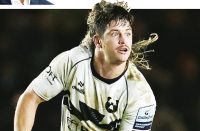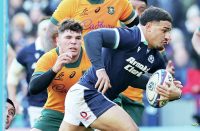 The England back three is going to change during the autumn series because Anthony Watson and Jack Nowell, the two wingers who have started most under Eddie Jones, are injured. That puts Semesa Rokoduguni and Marland Yarde, the two remaining fit wingers in the England squad, at the top of the list – and gives them a great opportunity to show what they can do.
The England back three is going to change during the autumn series because Anthony Watson and Jack Nowell, the two wingers who have started most under Eddie Jones, are injured. That puts Semesa Rokoduguni and Marland Yarde, the two remaining fit wingers in the England squad, at the top of the list – and gives them a great opportunity to show what they can do.
The other options available to the England coach are to move Mike Brown from full-back to wing, and bring in Alex Goode at 15, or alternatively to put one of his 13s, Jonathan Joseph or Elliot Daly, on the wing with the other staying at outside-centre.
The reason that I would not go for either of those options is because wing is one of the most exposed positions on the field, and that makes it difficult to move there either from full-back or outside-centre. Also, if you go that route, it conflicts with the view expressed by Jones that English rugby has a real depth of players.
Watson and Nowell are big losses because they are locked into the England pattern and both have played plenty of rugby at full-back, and are comfortable in the pendulum role of covering at 15. However, if I’m Rokoduguni or Yarde and the England coach decided to look to people in other positions to play wing, then I’m going to be thinking: “Why?”
Both wingers also have the advantage that they were at the Brighton training camp, and will therefore understand the shape and systems that Jones is looking for. Yarde’s form for Harlequins has been indifferent over the last year, but there were signs against Stade Francais on Thursday night that he is starting to rediscover the power and pace that earned him international recognition.
Rokoduguni is an interesting player, and has performed consistently well since winning his one cap under Stuart Lancaster. He doesn’t appear to be too big, or too quick, but he is very elusive. He has the Fijian gift of great balance in his running, but he is also a dense, hard, granite-like force of nature. He’s a tough cookie, and a threat every time he gets the ball.
If you watch Rokoduguni under the high ball, people often think they’ve got him, but are forced to think again – because they just seem to slide off him. He would be a good pick, and has earned his chance. Yarde is desperate to really establish himself, especially after rumours that he was dropped before the last World Cup because he wasn’t fit enough. The Quins wing has scored in both his last two games – and, if he can keep his eye in, his claim will be strong.
They seem by far the clearest options for Jones to take. Brown has played on the wing before for England, but neither he nor Goode are wingers, and that makes it a compromise. On the upside, Brown didn’t like wing much at Test level, but did well, and Goode has been consistently at the top of his game for Saracens.
There is a loss of pace, but that does not worry me overly because Brown counter-attacks well and is solid under the high ball, while Goode attacks from deep by gliding through gaps. And, if there is a hint of oxygen out there amid the suffocating defences, he finds it – and no-one has played as consistently well as Goode has.
Joseph and Daly are certainly quick enough to play on the wing, but neither of them are naturals. Daly’s outside-break and pass inside makes him the more likely wing of the two, whereas Joseph has more of a tendency to make his move once he has received the ball, using footwork, pace and hand-offs to find gaps.
Another option in the England 45-man squad is Jonny May, but the Gloucester wing has yet to play in the Premiership this season, and until he plays a couple of games for his club he cannot be seen as a serious contender.
At the moment, that means Jones is going to have to bring in players from outside the squad if he wants specialist replacement wingers. Matt Banahan’s form for Bath has been good enough to earn him recognition, and off the bench his versatility is another plus, while Christian Wade is another option.
Whenever Wade has been selected by England he has done well, but when the big chances have come along he has been injured. He also has the size issue to overcome. When you are a small wing, whatever your attacking brilliance, you have to prove to the coach you are the right choice in defence also.
So, just as the small but super-skilled James Simpson-Daniel proved himself against Jonah Lomu, you have to say to the coach: “I told you – I’m good enough.” Players of Wade’s size are considered to be a risk because teams will try to run through them, and they have to be strong enough defensively to stop that risk assessment being a factor.
In my view there are no risks with Banahan or Wade if they are selected as back-up, or part of the 23, because they are genuine wingers – and I would certainly look at them before putting Brown on the wing. Nor would I consider starting Joseph or Daly on the wing, although they could come off the bench as cover.
With only 35 international matches to go before the 2019 World Cup why mess around playing people out of position, especially if you know that you will not be considering playing someone like Brown on the wing in the tournament?
Wings might look similar to other backs but, as finishers, they think differently.
Back in 1997 I remember coming off the bench to play on the wing for England when Jon Sleightholme was injured. I never liked playing on the wing because I never felt comfortable there – and the only way I would have felt comfortable is with a season of it under my belt. But back then they didn’t get enough ball anyway, so I wouldn’t have considered it!
However, what separates the great wingers from the rest in the modern game is those who make themselves available for the full 80 minutes with great running off the ball, as well as on it – and to do that you’ve got to be one of the fittest guys in that position in the world.























